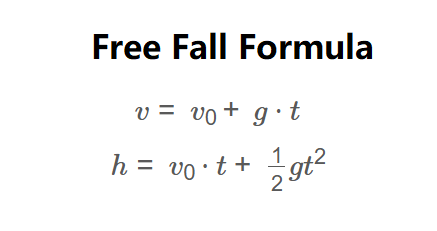1. What is the Free Fall Distance Calculator?
Definition: This calculator computes the velocity (\( v \)) and height (\( h \)) of an object in free fall based on gravitational acceleration (\( g \)), initial velocity (\( v_0 \)), and time of fall (\( t \)).
Purpose: It is used in physics, engineering, and education to analyze motion under gravity.
2. How Does the Calculator Work?
The calculator uses the following formulas:
\( v = v_0 + g \cdot t \)
\( h = v_0 \cdot t + \frac{1}{2} g t^2 \)
Where:
- \( g \): Gravitational acceleration (m/s², ft/s²);
- \( v_0 \): Initial velocity (m/s, ft/s, km/h);
- \( t \): Time of fall (s, min);
- \( v \): Final velocity (m/s, ft/s, km/h);
- \( h \): Height fallen (m, ft, km).
Steps:
- Enter the gravitational acceleration (\( g \)) with its unit.
- Enter the initial velocity (\( v_0 \)) with its unit.
- Enter the time of fall (\( t \)) with its unit.
- Convert all inputs to base SI units (m/s² for \( g \), m/s for \( v_0 \), s for \( t \)).
- Calculate the velocity using \( v = v_0 + g \cdot t \).
- Calculate the height using \( h = v_0 \cdot t + \frac{1}{2} g t^2 \).
- Convert the results to the selected output units.
- Display the results, formatted in scientific notation if the absolute value is less than 0.001, otherwise with 4 decimal places.
3. Importance of Free Fall Calculation
Calculating free fall distance and velocity is crucial for:
- Physics Education: Understanding motion under gravity.
- Engineering: Designing safety systems for falls.
- Astronomy: Analyzing planetary gravitational effects.
4. Using the Calculator
Example 1: Calculate the velocity and height for an object dropped from rest with \( g = 9.81 \, \text{m/s}^2 \) and \( t = 2 \, \text{s} \):
- Gravitational Acceleration: \( g = 9.81 \, \text{m/s}^2 \);
- Initial Velocity: \( v_0 = 0 \, \text{m/s} \);
- Time: \( t = 2 \, \text{s} \);
- Velocity: \( v = 0 + 9.81 \cdot 2 = 19.62 \, \text{m/s} \);
- Height: \( h = 0 \cdot 2 + \frac{1}{2} \cdot 9.81 \cdot 2^2 = 19.62 \, \text{m} \);
- Result (Velocity in m/s): \( v = 19.6200 \, \text{m/s} \);
- Result (Height in m): \( h = 19.6200 \, \text{m} \).
Example 2: Calculate the velocity and height for an object with \( g = 32.2 \, \text{ft/s}^2 \), \( v_0 = 10 \, \text{ft/s} \), and \( t = 1 \, \text{min} \):
- Gravitational Acceleration: \( g = 32.2 \, \text{ft/s}^2 \times 0.3048 = 9.81856 \, \text{m/s}^2 \);
- Initial Velocity: \( v_0 = 10 \, \text{ft/s} \times 0.3048 = 3.048 \, \text{m/s} \);
- Time: \( t = 1 \, \text{min} \times 60 = 60 \, \text{s} \);
- Velocity: \( v = 3.048 + 9.81856 \cdot 60 = 592.2636 \, \text{m/s} \);
- Height: \( h = 3.048 \cdot 60 + \frac{1}{2} \cdot 9.81856 \cdot 60^2 = 182.88 + 17673.648 = 17856.528 \, \text{m} \);
- Result (Velocity in ft/s): \( v = 1942.9134 \, \text{ft/s} \);
- Result (Height in ft): \( h = 58591.3386 \, \text{ft} \).
5. Frequently Asked Questions (FAQ)
Q: What is free fall?
A: Free fall is the motion of an object under the influence of gravity alone, with no other forces (e.g., air resistance) acting on it.
Q: Why does initial velocity matter?
A: If an object starts with an initial velocity (e.g., thrown downward), it affects both the final velocity and the distance fallen.
Q: Does this calculator account for air resistance?
A: No, this calculator assumes ideal conditions with no air resistance.
Free Fall Distance Calculator© - All Rights Reserved 2025
 Home
Home
 Back
Back
